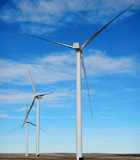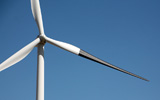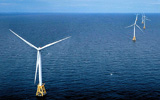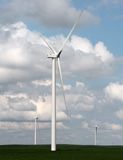Kansas Windscape
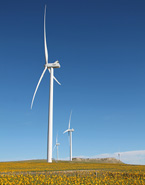
| and disinformation
James S. Aber and |
| Diurnal wind | Variable wind |
| Wind droughts | Texas energy fiasco |
| More myths | Fossil fuel competition |
| References |
A number of myths and considerable disinformation surround the subject of wind energy. Distortions and fake news have become increasingly common in recent years. Wind energy is not immune from this problem, which is driven by dubious news sources, social media, political agendas, and economic competition. Some of these myths are examined below based on factual historic information, technical data, and current scientific understanding.
The diurnal (24-hour) pattern of wind reflects daily heating from the Sun and cooling at night. Across the Great Plains of North America, for instance, wind is often nearly calm at sunrise and early morning. As the ground warms during the day, wind speed increases and typically reaches maximum velocity in the afternoon. As evening approaches, wind begins to lessen and may dissipate during the night. The peak interval for potential wind energy, thus, is during the hottest part of the day when electricity for air conditioning is most in demand during summer months.
Diurnal wind
One common myth is that most wind-generated electricity is produced at night when less electricity is needed. This oft-repeated claim is accepted uncritcially as a serious limitation for wind energy. This may be true in a few special circumstances, but it is simply wrong most of the time for most places. In fact, at most locations around the globe it is more windy during the daytime than at night (DWIA 2003). Afternoon peak in average daily wind speed is the norm in nearly all locales around the world (Aber et al. 2015). Passing storm systems or other atmospheric disturbances may, of course, upset this pattern for short time periods. But wind energy depends on long-term averages, not short-term deviations.Variable wind
Wind direction and speed change frequently in response to short-term weather events and seasonal conditions. Simply put, the wind is not constant at the ideal speed for turbines to produce their rated output continuously. In fact, local topography may induce substantial variations in near-surface wind, and individual turbines may respond in quite unexpected ways by facing in different directions.
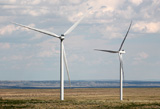
Adjacent working and rotating turbines face in different directions at nearly right angles. Vestas V120 turbines in the Busch Ranch II wind farm on the High Plains near Walsenburg, Colorado.
In general, it is well known that average wind speed over North America is related to climatic conditions in the Pacific region. The 2015 episode of low wind has been attributed to the North Pacific Mode state—and more specifically to high sea-surface temperatures (Lledó et al. 2018). Similar wind droughts have taken place in other locations, such as the United Kingdom in 2021 (Bloomfield 2021).
It should be noted that power generated by a turbine is related to the cube of the wind speed, thus, small changes in average wind speed have large consequences for generating electricity (Musgrove 2010). Projected global warming may lead to long-term reduction in wind speed in some areas, but cause increases in other places, according to some climate models (Bloomfield 2021). In general, much of the western and eastern United States may experience decreased average wind speeds. On the other hand, the central U.S. could develop increased wind in some seasons, particularly for the southern Great Plains (Chen 2020).
Indeed, a new scientific discipline has emerged, known as energy meteorology, in which climate is viewed as a resource, particularly for wind and solar energy (Olsson 1994). As our understanding of climate, especially wind variability and droughts, improves so will our decisions about wind energy and its deployment and operation in Kansas and around the world.
Hindsight has demonstrated the primary cause for this calamity was due largely to the failure of natural-gas-powered generators (Homeland Security 2021). This led to partial shutdown of the electric-grid system by the Electric Reliability Council of Texas (ERCoT), which is independent of other electric-grid interconnections—see electricity grid. The disconnection of ERCoT made it difficult, in fact nearly impossible, to import electricity from outside the state.
Texas had been warned a decade before that its electric-grid system was vulnerable to failure during cold weather. But this warning went unheeded. In fact, cold weather had caused previous system-wide rolling blackouts, most noteably in 1989 (Homeland Security 2021), long before wind energy came to Texas. So the potential for cold-weather impact on ERCoT was well known.
Wind turbines and natural gas certainly may be prepared for operation in extreme cold conditions, such as the northern Great Plains. Wind turbines, in particular, are abundant in Iowa, Minnesota, North Dakota, Montana, and Wyoming, states known for bitter cold winters, as well as the Canadian Prairie region. Nickel-stainless-steel alloys are used for key components along with other cold-climate options for low-temperature turbine operation. Typical Vestas turbine models, for instance, are rated for operation down to -30 °C (-22 °F) and for withstanding ambient temperature as low as -40 °C (-40 °F). See Vestas cold climate.
Wind-turbine syndrome – many maladies supposedly are linked to wind turbines including vertigo, nausea, autism, tinnitus, fatigue, memory loss, depression, and migraines, to name a few. Taken together, wind-turbine syndrome is not a medically recognized diagnosis. According to the Ohio Department of Health, there is no significant body of peer-reviewed, scientific evidence that clearly demonstrates a direct link between adverse physical health effects and exposures to noise (audible, LFN, or infrasound), visual phenomena (shadow flicker), or EMF associated with wind turbine projects (ODH 2022).
Wind-turbine radiation – exposure to electromagnetic field (EMF) radiated by turbines. Wind turbines do cause interference for AM radio reception, and some people have complained about this. According to the U.S. Environmental Protection Agency, field measurements show EMF levels near wind turbines are well below any existing regulatory guidelines with respect to human health and are, in fact, lower than those produced by many common household electrical devices (EPA Safety 2024).
As recently as 1999, for example, the American Association of Petroleum Geologists (AAPG) rejected the likelihood that human activity, namely burning fossil fuels, has any influence on global climate change (Bean 2012). AAPG has since softened its position on this subject, but opposition to development of wind energy remains strong even today among many in the fossil-fuel industries.
According to the Global Wind Energy Council, disinformation campaigns against wind energy are orchestrated and financed by fossil-fuel interest groups (GWEC 2025). Various other disparate groups have joined the anti-wind movement as well. Furthermore, many large wind farms are owned and operated by major oil companies, which leads to a complicated situation (Westervelt 2024).
Text and images © J.S. and S.E.W. Aber.
Wind droughts
The term wind drought was coined in connection with a prolonged interval of low wind speed in the United States during the first three months of 2015, and this substantially reduced electric-power generation of wind farms. Similar calm periods on the high seas have been known to sailors for centuries. Nonetheless, wind droughts are another myth about the viability of wind energy.Texas energy fiasco
The energy infrastructure of Texas suffered its worst failure in February 2021 as a result from a series of severe winter storms. More than 4˝ million homes and businesses lost power; there were shortages of water, food, and heat, and about 250 people died as direct or indirect results. Texas Governor Abbott and others initially blamed frozen wind turbines and solar panels—another deception.
![]() Wyoming wind turbines
Wyoming wind turbines
Wind farms near Glenrock in central Wyoming. Pioneer Wind Park (left) reaches 2100 m (6900 feet) elevation. Rolling Hills (right) is at 1650 m (5400 feet) elevation; both are equipped with GE Wind turbines. Winter low temperature in this vicinity may dip below -30 °C (-22 °F). See Glenrock temperature record.
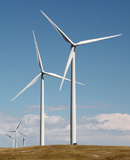
![]() Back to beginning.
Back to beginning.More myths and disinformation
Anti-wind politics – conservative politicians across the United States are promoting legislation at the state level that would restrict development of wind farms (Miller 2023). They have branded wind energy as a "liberal symbol" that should be opposed on cultural rather than technical grounds. Election of President Trump to a second term may exacerbate this situation. This point of view is divisive, shortsighted, self-serving, and cynical, given the large economic impact of wind energy.

Yard sign in opposition to wind turbines displayed
in Belleville, Republic County, north-central Kansas.
Fossil fuel competition
Many people involved with the fossil-fuel industry regard wind energy as an economic competitor. This point of view is questionable given rapid global increases in use of fossil fuels, which grew by nearly 50% between 2000 and 2023 (Ritchie and Rosado 2024). Nonetheless, fossil-fuel producers have waged long-running and well-financed disinformation efforts against climate science and wind energy (Negin 2022).

Frank and Ernest. Adapted from Emporia Gazette, April 22, 2025.
![]() Back to beginning.
Back to beginning.
References
![]() Back to beginning.
Back to beginning.![]()
All rights reserved.![]() Return to Kansas windscape homepage.
Return to Kansas windscape homepage.
Last update: July 2025.
